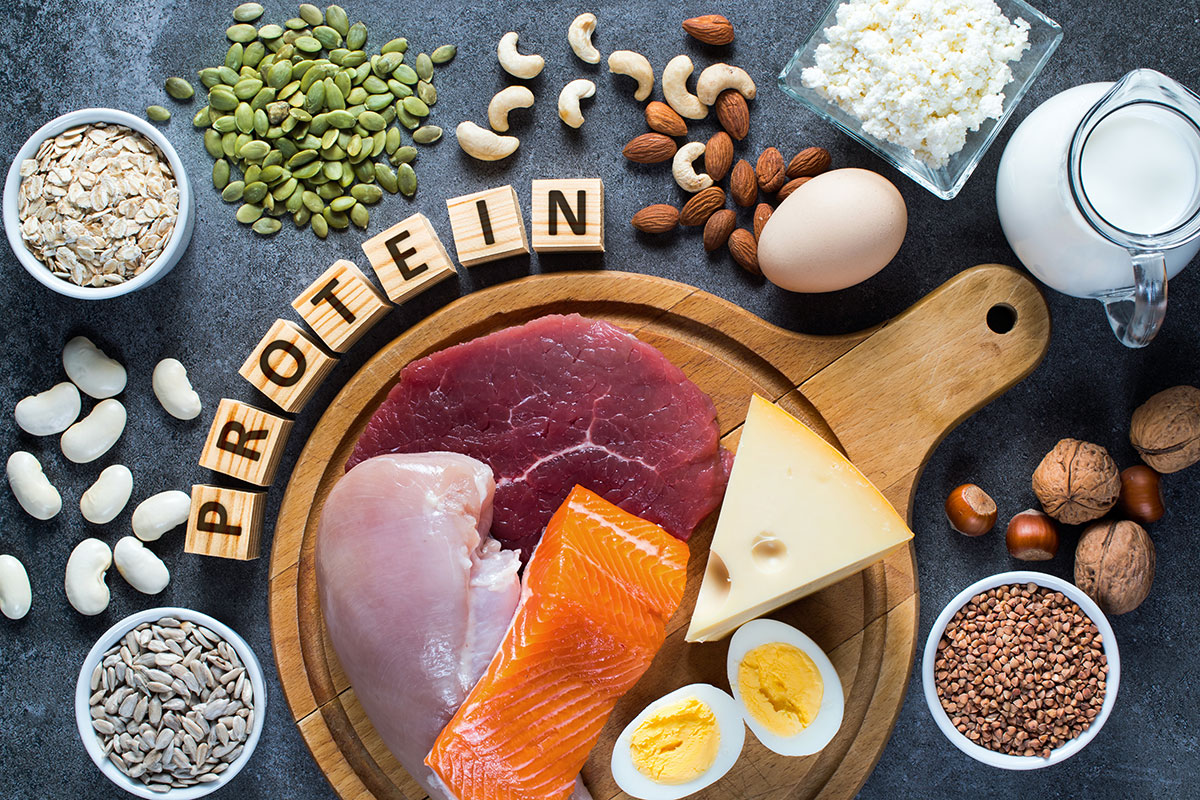Get a Free box of Gummies ($120 value) when you spend $200 or more. Now through Monday

A healthy diet and optimal nutrition are key pillars for promoting wellness. However, the media platforms that we often engage in, sometimes overemphasize single nutrients, leaving us hyper-focused on what may lead to an imbalance in our dietary intake. Some recommendations tell us to cut our carbohydrates, while others advise adding too much protein. It is important to keep top of mind that a balanced diet provides a wide variety of essential nutrients from all food groups.
A one-size-fits-all nutrition plan or health advice is not helpful, nor is it recommended. Understanding general protein requirements, however, can be helpful in planning a balanced diet that includes lean protein food choices.
This article highlights the importance of protein in your diet. We also examine dietary protein sources and an individual’s basic protein requirements by age.
For personalized advice, consult your healthcare provider. They can help to determine your overall nutrition and protein requirements. This article provides basic education and does not provide medical or nutrition advice.
Protein is one of the three important nutrients that make up a large part of our diet. These nutrients are called macronutrients — macros meaning large. Carbohydrates, fats, and proteins are the main macronutrients (macros) in our diets that provide energy.
Proteins are formed by basic units called amino acids that are joined together by specific bonds. There are 20 different amino acids that make up various proteins in the different organs in our body. A variety of amino acids are also provided by both animal and plant-based protein-rich foods in our diet. When dietary proteins are digested, free or individual amino acids are released, absorbed, and used by the body.
All amino acids are equally important even though they are classified into different types which include essential amino acids, non-essential amino acids, and conditionally essential amino acids.
Essential amino acids. Essential amino acids are amino acids that the body cannot produce. Therefore, you need to obtain these amino acids from the foods in your diet. There are 9 essential amino acids. They include:1,2
Non-essential amino acids. Non-essential amino acids are made by the body. Therefore, you do not need to worry about sourcing these 11 amino acids from foods in your diet. They include the following:1,2
Cysteine and tyrosine are 2 non-essential amino acids that under certain conditions become essential. These are known as conditionally essential amino acids.1,2
There are 2 main types of dietary proteins that include:
Complete proteins. Dietary protein sources that contain all 9 essential amino acids are considered complete proteins. Some animal protein sources include dairy, poultry, fish, and meats like pork and beef. There are also a few plant-based sources of complete protein, including tempeh, edamame, tofu, miso, and quinoa.3
Incomplete proteins. Incomplete proteins contain some of the 9 essential amino acids, but not all of them. This, however, is not a concern since a balanced diet that incorporates a variety of protein-rich foods allows for a natural way for most to meet their protein requirements. Some examples of incomplete protein foods include vegetables, beans, peas, lentils, whole grains, nuts and seeds.3
Most people know protein helps build and repair cells and body tissue. This is a key function, yet protein offers much more for good health. Protein also has many other vital roles in the body. We list some below.4
It is pretty amazing to see how important this macronutrient is for supporting our overall health. Now let’s look to see the general protein requirements that we need on a daily basis, while keeping in mind that everyone’s health and nutrition needs are different, it’s important to confer with your healthcare provider to establish your protein requirements.
How much protein should you consume? The Food and Nutrition Board, Institute of Medicine, and National Academies have established protein requirements that are generally based on your age and gender as provided through the Recommended Daily Allowance or RDA.5 There are, however, other factors that may affect the amount of protein a person needs.
For example, women who are pregnant or breastfeeding have increased protein needs and should discuss their specific protein requirements with their healthcare provider. Physically active individuals may also need higher protein intake to support their activity levels. People with certain medical conditions may have modified protein requirements that require either an increase or decrease in their protein consumption.
To ensure you meet your nutrition goals and specific protein requirements, it is best to consult with your healthcare provider. Working with a Registered Dietitian (RD) is also advantageous because they can help you to plan a balanced meal plan while working together with your HCP.
General protein guidelines have been developed and published for the public by the United States Department of Agriculture (USDA) through MyPlate.
Here are general protein recommendations by MyPlate shared by the American Academy of Nutrition and Dietetics. These general protein requirements are for individuals ages 2 and older.4
Age Gender Daily Protein Recommendation
2-3 years Female and male 2 to 4 ounce equivalents
4-8 years Female and male 3 to 5½ ounce equivalents
9-13 years Female 4 to 6 ounce equivalents
9-13 years Male 5 to 6½ ounce equivalents
14-18 years Female 5 to 6½ ounce equivalents
14-18 years Male 5½ to 7 ounce equivalents
19-30 years Female 5 to 6½ ounce equivalents
19-30 years Male 6½ to 7 ounce equivalents
31-50 years Female 5 to 6 ounce equivalents
31-50 years Male 6 to 7 ounce equivalents
51 years and older Female 5 to 6 ounce equivalents
51 years and older Male 5½ to 6½ ounce equivalents
Consuming a balanced diet is an essential part of achieving and maintaining good health. A common question is, “How much protein should you consume?�? The answer depends on factors such as age, gender, activity level, and overall health needs. Understanding protein requirements by age can help guide balanced dietary choices, ensuring you get the right amount of protein at different stages of life.
Including a variety of foods from all of the food groups—including fruits, vegetables, whole grains, lean proteins, and healthy fats like extra virgin olive oil—provides essential vitamins, minerals, fiber, antioxidants, and the macronutrients like protein that we need. Varying the types of protein we eat is not only necessary but it also adds variety to a savory dish.
We should speak with a Registered Dietitian and our HCP to establish an eating plan that best complements our health needs. Relying on the ‘latest trend’ is not only not advised, it’s just not wise. Instead, focusing on a balanced, nutrient-rich diet supports overall health and longevity, helping us feel our best for years to come.
For more information on how nutrition varies for different lifestyles, check out our other blogs on men’s diet and women’s nutrition.
*These statements have not been evaluated by the Food and Drug Administration. These products are not intended to diagnose, treat, cure, mitigate, or prevent any disease. Individual results may vary.

Ken Swartz, MS is the co-founder, Chairman Emeritus, and former Chief Science Officer at C60 Power, a health and wellness company committed to delivering the highest quality Carbon 60 products available. Ken earned a Master of Science degree from the University of Colorado at Denver and a Bachelor of Science in Economics from Arizona State University.’